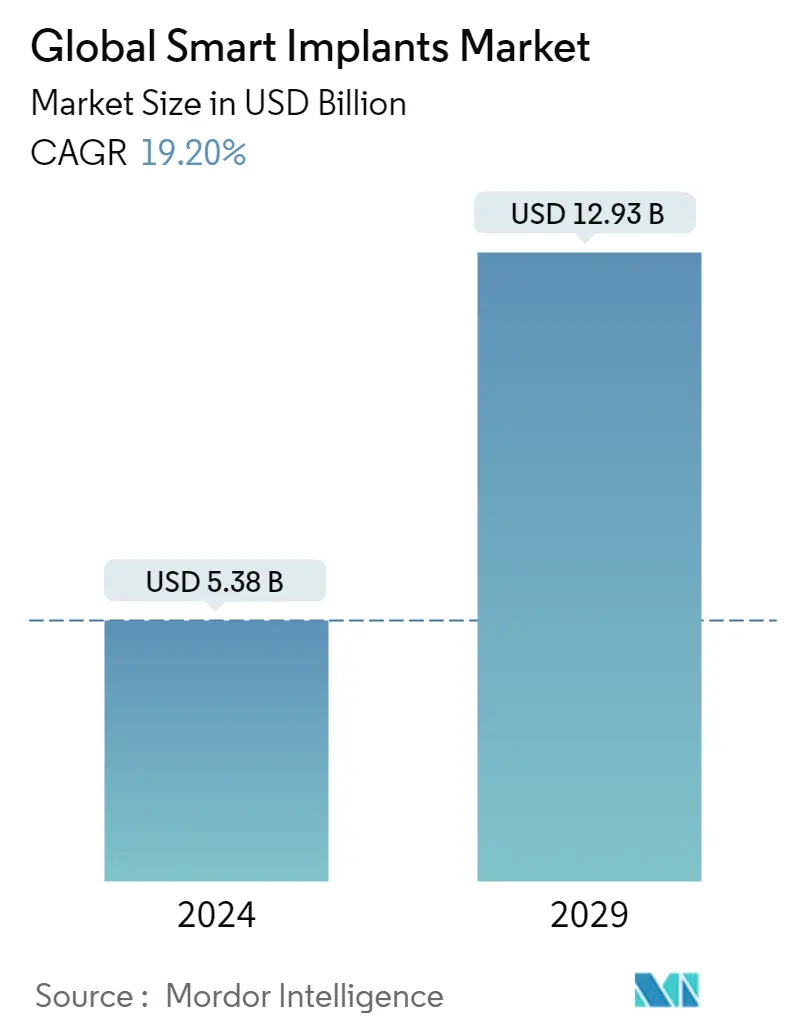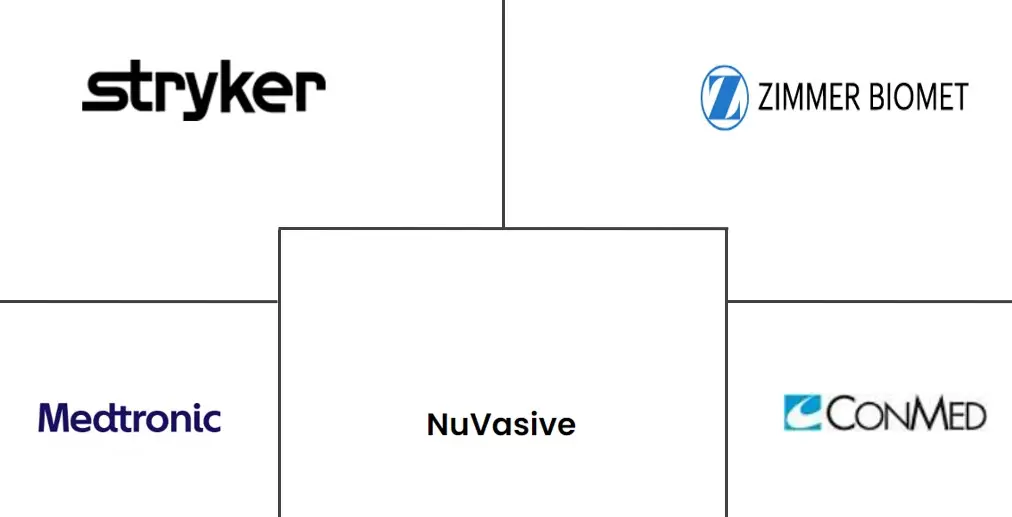Market Size of Global Smart Implants Industry

| Study Period | 2019 - 2029 |
| Market Size (2024) | USD 5.38 Billion |
| Market Size (2029) | USD 12.93 Billion |
| CAGR (2024 - 2029) | 19.20 % |
| Fastest Growing Market | Asia-Pacific |
| Largest Market | North America |
Major Players
*Disclaimer: Major Players sorted in no particular order |
Smart Implants Market Analysis
The Global Smart Implants Market size is estimated at USD 5.38 billion in 2024, and is expected to reach USD 12.93 billion by 2029, growing at a CAGR of 19.20% during the forecast period (2024-2029).
COVID-19 pandemic had a substantial impact on the smart implants market, specifically for dental services. The strict lockdowns and government regulations intended to slow down the spread of COVID-19 resulted in a decrease in demand for products across all segments. In wake of COVID-19 outbreak, various organizations, such as, American Dental Association (ADA)15 and the American Dental Hygienists' Association (ADHA)16 have recommended postponing all elective dental procedures and provision of noncritical dental care. The Centers for Medicare and Medicaid Services recommend that all nonessential examinations and procedures must be postponed until further notice. As per the articles published in March 2022 titled 'Aerosols generated by high-speed handpiece and ultrasonic unit during endodontic coronal access alluding to the COVID-19 pandemic' in Springer Nature, there is a risk of transmission of Covid-19, in dental practice from blood or saliva, combined with instruments that generate aerosols.
Furthermore, as per the data provided by The Pandemic Practice, Anxiety, Coping, and Support Survey for Vascular Surgeons 2021, the majority of respondents (91.7%) noted elective surgery cancellation. Thus, the COVID-19 outbreak affected the market's growth adversely for most of the implant surgeries; however, the market is expected to gain traction due to the significant increase in the use of smart implant devices globally.
Further, an increase in the geriatric population with various chronic disorders, rising incidence of accidents or sports injuries, and technological advancements in the field of smart implants are among the major factors driving the growth of the studied market. Currently, smart implants have the potential to reduce the infection at the site, speedy recovery and reduced readmission may support the growth in the future. Such factors are likely to boost the adoption of smart implants, thereby contributing to the studied market growth.
In addition, new product launches and strategic activities by major players in the market are positively affecting the growth of the studied market. For instance, in August 2020 Zimmer Biomet Holdings announced U.S. Food and Drug Administration (FDA) has granted authorization to market the tibial extension for Persona IQ. Additionally, in August 2021, The Johnson & Johnson introduces the INHANCE Shoulder System designed with patient care approach. Thus, owing to the product launches the studied market is expected to have significant growth over the forecast period.
Therefore, owing to the aforementioned factors the studied market is anticipated to witness growth over the analysis period. However, the high cost of implants & Stringent Regulatory Framework is likely to impede market growth.
Smart Implants Industry Segmentation
As per the scope of the report, smart implants are personalized bio-implants that feature customized shapes, special functions such as sensor technology or shape memory in combination with flexible and durable biomaterials. Smart implants are novel, minimally invasive and cost-efficient. The Smart Implants market is segmented by Application (Orthopedic Smart Implants, Cardiovascular Smart Implants, Ophthalmic Smart Implants, Dental Smart Implants, Cosmetics Smart Implants and Others), End-User (Hospitals, Ambulatory Surgical Centers, Speciality centers and Other End-Users), and Geography (North America, Europe, Asia-Pacific, Middle East and Africa, and South America). The report offers the value (in USD million) for the above segments.) The market report also covers the estimated market sizes and trends for 17 different countries across major regions, globally. The report offers the value (in USD million) for the above segments.
| By Product Type | |||||||
| |||||||
| |||||||
| |||||||
| Dental Smart Implants | |||||||
| Cosmetic smart Implants | |||||||
| Others |
| By End User | |
| Hospitals | |
| Ambulatory Surgical Centers | |
| Orthopedics Clinics | |
| Opthalmic Clinics | |
| Dental Labs | |
| Others |
| Geography | ||||||||
| ||||||||
| ||||||||
| ||||||||
| ||||||||
|
Global Smart Implants Market Size Summary
The smart implants market is poised for significant growth, driven by technological advancements and increasing adoption across various medical fields. The market is experiencing a resurgence following the disruptions caused by the COVID-19 pandemic, which had a notable impact on elective procedures, particularly in dental services. However, the demand for smart implants is expected to rise due to their potential benefits, such as reduced infection rates, faster recovery, and decreased readmission rates. Factors such as the aging population, rising incidence of accidents and sports injuries, and continuous innovation in smart implant technology are contributing to the market's expansion. The introduction of new products and strategic initiatives by key players further bolsters market growth, despite challenges like high costs and stringent regulatory frameworks.
North America is anticipated to lead the smart implants market, supported by advanced healthcare infrastructure, high consumer awareness, and the presence of major pharmaceutical and biotechnology companies. The region's growth is fueled by the availability of technologically advanced products and a high concentration of market players. Key product launches and regulatory approvals, such as Medtronic's Vanta device and Zimmer Biomet's Persona IQ, are driving market dynamics in the United States. The market is characterized by a consolidated nature, with major companies focusing on technological advancements to capture a larger market share. As the adoption of smart implants increases, particularly in orthopedic applications, the market is expected to witness substantial growth over the forecast period.
Global Smart Implants Market Size - Table of Contents
-
1. MARKET DYNAMICS
-
1.1 Market Overview
-
1.2 Market Driver
-
1.2.1 Increase in the Geriatric Population with Various Chronic Disorder
-
1.2.2 Rising Incidence of Accidents and Sport Injuries
-
1.2.3 Technological Advancements in the Field of Smart Implants
-
-
1.3 Market Restraints
-
1.3.1 Stringent Regulatory Framework
-
-
1.4 Porter's Five Force Analysis
-
1.4.1 Threat of New Entrants
-
1.4.2 Bargaining Power of Buyers/Consumers
-
1.4.3 Bargaining Power of Suppliers
-
1.4.4 Threat of Substitute Products
-
1.4.5 Intensity of Competitive Rivalry
-
-
-
2. MARKET SEGMENTATION
-
2.1 By Product Type
-
2.1.1 Orthopedics Smart Implants
-
2.1.1.1 Knee Arthroplasty
-
2.1.1.2 Hip Arthroplasty
-
2.1.1.3 Spine Fusion
-
2.1.1.4 Fracture Fixation
-
2.1.1.5 Others
-
-
2.1.2 Cardiovascular Smart Implants
-
2.1.2.1 Pacing devices
-
2.1.2.2 Stents
-
2.1.2.3 Structural Cardiac Implants
-
-
2.1.3 Opthalmic Smart Implants
-
2.1.3.1 Intraocular lens
-
2.1.3.2 Glaucoma Implants
-
-
2.1.4 Dental Smart Implants
-
2.1.5 Cosmetic smart Implants
-
2.1.6 Others
-
-
2.2 By End User
-
2.2.1 Hospitals
-
2.2.2 Ambulatory Surgical Centers
-
2.2.3 Orthopedics Clinics
-
2.2.4 Opthalmic Clinics
-
2.2.5 Dental Labs
-
2.2.6 Others
-
-
2.3 Geography
-
2.3.1 North America
-
2.3.1.1 United States
-
2.3.1.2 Canada
-
2.3.1.3 Mexico
-
-
2.3.2 Europe
-
2.3.2.1 Germany
-
2.3.2.2 United Kingdom
-
2.3.2.3 France
-
2.3.2.4 Italy
-
2.3.2.5 Spain
-
2.3.2.6 Rest of Europe
-
-
2.3.3 Asia-Pacific
-
2.3.3.1 China
-
2.3.3.2 Japan
-
2.3.3.3 India
-
2.3.3.4 Australia
-
2.3.3.5 South Korea
-
2.3.3.6 Rest of Asia-Pacific
-
-
2.3.4 Middle-East and Africa
-
2.3.4.1 GCC
-
2.3.4.2 South Africa
-
2.3.4.3 Rest of Middle-East and Africa
-
-
2.3.5 South America
-
2.3.5.1 Brazil
-
2.3.5.2 Argentina
-
2.3.5.3 Rest of South America
-
-
-
Global Smart Implants Market Size FAQs
How big is the Global Smart Implants Market?
The Global Smart Implants Market size is expected to reach USD 5.38 billion in 2024 and grow at a CAGR of 19.20% to reach USD 12.93 billion by 2029.
What is the current Global Smart Implants Market size?
In 2024, the Global Smart Implants Market size is expected to reach USD 5.38 billion.

